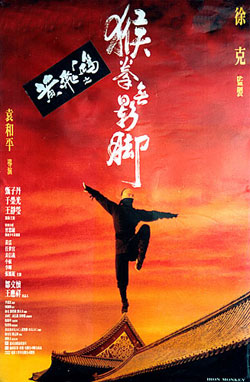These are the 1993 Endy Awards, wherein I pretend to give out maneki-neko statues to the best in that year in film. Awards for many other years can be found in the Endy Awards Index. Eligibility is determined by imdb date and by whether or not I’ve seen the movie in question. Nominees are listed in alphabetical order and the winners are bolded. And the Endy goes to. . .
Best Picture:
1. The Age of Innocence
2. Dazed and Confused
3. Green Snake
4. Iron Monkey
5. Matinee
6. The Piano
7. The Puppetmaster
8. Six Degrees of Separation
9. Sonatine
10. Three Colors: Blue
Best Director:
1. Martin Scorsese, The Age of Innocence
2. Richard Linklater, Dazed and Confused
3. Tsui Hark, Green Snake
4. Hou Hsiao-hsien, The Puppetmaster
5. Krzysztof Kieślowski, Three Colors: Blue
Linklater’s chronicle of the last day of school/first night of summer of a bygone era grows as it recedes in the memory. 20 years ago it was a goofy bit of comic nostalgia, an excuse to laugh at 70s fashions and the importance of Aerosmith. But the older I get, the better it gets. But I just recently watched The Age of Innocence again, and it’s now my favorite Martin Scorsese movie and I’m giving it the Endy here. This is Scorsese’s first directing nomination, but surely not his last. It’s Hou’s sixth nomination.
Best Actor:
1. Daniel Day-Lewis, The Age of Innocence
2. Bill Murray, Groundhog Day
3. Arnold Schwarzenegger, The Last Action Hero
4. Anthony Hopkins, Shadowlands
5. Takeshi Kitano, Sonatine
Best Actress:
1. Brigitte Lin, The East is Red
2. Maggie Cheung, Green Snake
3. Holly Hunter, The Piano
4. Stockard Channing, Six Degrees of Separation
5. Juliette Binoche, Three Colors: Blue
This is Murray’s fourth nomination (third in Best Actor) and his first win. Binoche won previously in 2007 and 2010. This is Cheung’s fifth nomination (fourth in Best Actress) with no wins as yet.
Supporting Actor:
1. John Goodman, Matinee
2. Larenz Tate, Menace II Society
3. Li Tien-lu, The Puppetmaster
4. Will Smith, Six Degrees of Separation
5. Val Kilmer, Tombstone
Also receiving votes: Harvey Keitel (The Piano), Tony Leung Ka-fai (He Ain’t Heavy, He’s My Father), Dennis Hopper (True Romance), Ralph Fiennes (Schindler’s List), Sean Penn (Carlito’s Way), Matthew McConaughey (Dazed and Confused), John Malkovich (In the Line of Fire), and Kevin Costner (A Perfect World). This is the best selection of Supporting Actors I’ve seen in the course of handing out the Endys. Of course I’m giving the award to the guy who’s playing himself.
Supporting Actress:
1. Christina Ricci, Addams Family Values
2. Winona Ryder, The Age of Innocence
3. Josephine Siao, Fong Sai-yuk
4. Joey Wang, Green Snake
5. Emma Thompson, Much Ado About Nothing
The Supporting Actress group this year is not as good, but still has a pair of all-time great performances. Josephine Siao, with the best supporting performance in a kung fu comedy ever, just edges out Ryder’s career-best performance.

Original Screenplay:
1. Richard Linlater, Dazed and Confused
2. Danny Rubin & Harold Ramis, Groundhog Day
3. Jane Campion, The Piano
4. Chu Tien-wen & Wu Nien-jen, The Puppetmaster
5. Krzysztof Kieślowski & Krzysztof Piesiewicz, Three Colors: Blue
Adapted Screenplay:
1. Jay Cocks & Martin Scorsese, The Age of Innocence
2. Lillian Lee & Tsui Hark, Green Snake
3. Steven Zaillian, Searching for Bobby Fischer
4. John Guare, Six Degrees of Separation
5. Robert Altman & Frank Barhydt, Short Cuts
Non-English Language Film:
1. Green Snake (Tsui Hark)
2. Iron Monkey (Yuen Woo-ping)
3. Sonatine (Takeshi Kitano)
4. The Puppetmaster (Hou Hsiao-hsien)
5. Three Colors: Blue (Krzysztof Kieślowski)
Three Colors: Blue was the first art film I ever saw that made me want to watch and rewatch it until I took it all in and felt I really understood what was happening and why. As such, it’s probably overrated in my memory. I can’t tell and I don’t care: these are my fake movie awards.
Non-Fiction Film:
1. Latcho Drom (Tony Gatlif)
2. The War Room (Chris Hegedus & D.A. Pennebaker)
Animated Film:
1. The Nightmare Before Christmas (Henry Selick)
2. Ninja Scroll (Yoshiaki Kawajiri)
Unseen Film:
1. Blue (Derek Jarman)
2. The Blue Kite (Tian Zhuangzhuang)
3. Naked (Mike Leigh)
4. Stalingrad (Joseph Vilsmaier)
5. 32 Short Films About Glenn Gould (François Girard)
Also receiving votes: Madadayo (Akira Kurosawa), Surviving Desire (Hal Hartley), The Scent of Green Papaya (Tran Anh Hung), Smoking/No Smoking (Alain Resnais), Caro diario (Nanni Moretti), Fearless (Peter Weir), and M. Butterfly (David Cronenberg).

Film Editing:
1. The Age of Innocence
2. Dazed and Confused
3. The Piano
4. The Puppetmaster
5. Three Colors: Blue
Those dissolves.
Cinematography:
1. The Age of Innocence
2. Green Snake
3. The Piano
4. Schindler’s List
5. Three Colors: Blue
Art Direction:
1. The Age of Innocence
2. Green Snake
3. Matinee
4. The Piano
5. The Puppetmaster
Costume Design:
1. The Age of Innocence
2. The Eagle Shooting Heroes
3. Green Snake
4. The Heroic Trio
5. Matinee
Mant vs. Maggie Cheung. Mant wins.
Make-up:
1. Army of Darkness
2. The Bride with White Hair
3. The Eagle-Shooting Heroes
4. Executioners
5. Matinee

Original Score:
1. Jurassic Park
2. The Nightmare Before Christmas
3. The Piano
4. Schindler’s List
5. Three Colors: Blue
Adapted Score:
1. Coneheads
2. Dazed and Confused
3. Judgement Night
4. Matinee
5. True Romance
Sound:
1. Jurassic Park
2. The Piano
3. The Puppetmaster
4. Schindler’s List
5. Three Colors: Blue
Sound Editing:
1. Gettysburg
2. Jurassic Park
3. The Last Action Hero
4. Schindler’s List
5. True Romance
Visual Effects:
1. Army of Darkness
2. Green Snake
3. Jurassic Park
4. Kung Fu Cult Master
5. Matinee























